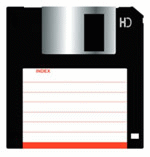IT REVOLUTIONISED home computing, became an everyday icon of the late 20th century and inspired the design for the best-selling 12in single of all time.
 But the floppy disk, which heralded a new information age when it launched 36 years ago, is to disappear from the shelves after being made obsolete by a new generation of technology.
But the floppy disk, which heralded a new information age when it launched 36 years ago, is to disappear from the shelves after being made obsolete by a new generation of technology.
PC World, Britain's biggest chain of computer stores, has announced it will no longer sell the diskettes when current stocks have been sold.
In 1998, more than two billion 3.5in disks were sold worldwide according to the Recording Media Industries Association of Japan.
That figure is now less than 700 million and shrinking rapidly as e-mail and giant hard drives become the best way of swapping and storing data.
But while part of technological history, the floppies - so-called because early versions were flimsy 8in magnetic strips - appear not to have earned the affection of computer users.
"Floppy disks are the computing equivalent of cassette tapes," said technology writer Nick Clayton.
"They were part of our lives but I don't suppose they have captured the imagination in the same way as vinyl records.
"They have been just a temporary technology, a means of storing data until such time as more efficient systems came on the market. They have no intrinsic value."
He added: "The only ones who might lament the passing of floppy disks will be film directors, because action movies like Matrix always seem to feature a special disk that contains some sort of vital information."
The floppy was invented in 1971 by IBM engineers in California led by Alan Shugart and replaced old-fashioned punch-cards, which made computer systems too vast to be used by all but the largest of businesses.
Initially 8in wide magnetic strips, they evolved into a 5.25in disk and subsequently into a 3.5in version encased in hard plastic, which was launched by Sony in the 1980s.
The disks were used to distribute software, transfer data between computers and create small backups. Before the popularisation of the hard drive for personal computers, floppy disks were typically used to store a computer's operating system (OS), application software, and other data.
Such was the iconic status of the floppy disk in the 1980s that Factory Records artist Peter Saville used it as the sleeve design for New Order's 1983 single Blue Monday, the best-selling 12in single ever released.
Apple was the first major mass-market manufacturer to drop the floppy drive from a computer model altogether, with the release of the iMac in 1998, while Dell made the floppy drive optional starting in 2003.
"I'm not sure whether Apple was prescient or premature," added Mr Clayton. "The disks stayed around for a while, although, like most people these days, I tend to come across them only when tidying up."
A spokesman for the British Computing Society said: "I don't think they will be missed, and frankly it is amazing we put up with them for so long.
"They were frustratingly limited in their capacity, prone to damage and were susceptible to dirt and dust. I haven't seen one around here for many years."
Bryan Magrath, commercial director of PC World, said: "The sound of a computer's floppy disk drive will be as closely associated with 20th century computing as the sound of a computer dialling in to the internet.
"The pace of technological change is relentless and it is now increasingly standard for computer users to transfer data via the internet or with USB memory sticks, some of which will store the equivalent of 1,000 times the capacity of floppy disk. With that amount of memory available in such a small and convenient device, the floppy disk looks increasingly quaint and simply isn't able to compete."
Shugart himself died last month, aged 76. In 1996 he launched an unsuccessful campaign to elect his dog, Ernest, to Congress and four years later backed a failed bid to give California voters the option of choosing "none of the above" in elections.
DISKS HAD THEIR CHIPS
THE ubiquity of broadband internet, which can transfer more data in a single second than could be stored on a 3.5in disk, has proved the final nail in the coffin for the "floppy".
Memory sticks, which can carry up to 1,000 times as much information and are not rendered useless by a rogue speck of dust, have already taken the place of disks for portable storage of files.
The rot set in during the late 1980s, when the arrival of the CD signalled the start of a new era.
More significantly, the widespread use of e-mail eliminated the need to transfer files manually.
Even for new technology in the 21st century, obsolescence beckons. Two of the world's biggest computer companies are currently battling it out in a technology war. Intel and IBM are both promising the biggest breakthrough in 40 years: more efficient transistors, which control current change and are key to functioning electronics.
Intel said it had developed a much more efficient and dense transistor - a 45 nanometer transistor - which ran faster and consumed less power.
It would also reduce the problem of leaking current, which slows transistor performance. In the past, the smaller the chip, the higher the leakage.
Meanwhile, IBM announced its own improved transistor and said the new technology could be incorporated into existing chip manufacture to keep costs down.

Add a Comment
No messages on this article yet